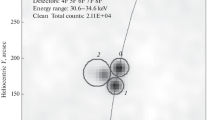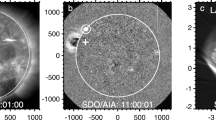Abstract
The Nobeyama Radioheliograph observation results and data from the KONUS-Wind spectrometer mounted at the Wind and RHESSI satellites on several solar flares are jointly analyzed. The analysis results for data on the flare of July 18, 2002 are described. The hard X-rays were measured in the 18 keV-15 MeV range (KONUS-Wind), and spectroheliograph measurements were carried out in the radio range at frequencies of 17 and 34 GHz. Spatial distributions of the radio brightness were calculated for the flare of July 18, 2002; they show the presence of two sources at the footpoints and one source at the top of the supposed flaring loop. The energy spectra of hard X-rays, energy flux, and the total number of accelerated electrons were found from the KONUS spectrometer data. The number of accelerated X-ray emitted electrons was estimated as N ≥ 1036, and the maximum X-ray energy flux was estimated as ∼5 × 10−6 erg cm−2 s−1. The spectrum index varies in time from −4.6 to −3.6, i.e., the soft-hard-harder trend is implemented. The spectral index of the radio waves is α ≈ −0.3 at the flare start, attains the value α ≈ −0.5 at the flux maximum, and even change the sign further. The accelerated electron transport model in the flare loop plasma is suggested for interpretation of relationships between parameters of the radio emission and hard X-rays.
Similar content being viewed by others
References
Aptekar, R.L., Frederiks, D.D., Golenetskii, S.V., et al., Konus-W gamma-ray burst experiment for the GGS Wind spacecraft, Space Sci. Rev., 1995, vol. 71, pp. 265–272.
Aschwanden, M.J. and Schwartz, R.A., The inversion electron time-of -flight distances from hard X-ray time delay measurements, Astrophys. J., 1996, vol. 464, pp. 974–984.
Aschwanden, M.J., Brown, J.C., and Kontar, E.P., Chromospheric height and density measurements in a solar flare observed with RHESSI II. Data analysis, Sol. Phys., 2002, vol. 210, pp. 383–405.
Bai, T. and Ramaty, R., Backscatter, anisotropy and polarization of solar hard X-rays, Astrophys. Jo., 1978, vol. 219, pp. 705–726.
Charikov, Yu.E., Melnikov, V.F., and Kudryavtsev, I.V., Intensity and polarization of the hard X-ray radiation of solar flares at the top and footpoints of a magnetic loop, Geomagn. Aeron. (Engl. Transl.), 2012, vol. 52, no. 8, pp. 1021–1031.
Cornell, M.E., Harford, G.J., Kiplinger, A.L., and Dennis, B.R., The relative timing of microwaves and hard X-rays in solar flares, Astrophys. J., 1984, vol. 279, pp. 875–881.
Fleishman, G.D. and Melnikov, V.F., Gyrosynchrotron emission from anisotropic electron distributions, Astrophys. J., 2003, vol. 587, pp. 823–835.
Hamilton, R.J., Lu, E.T., and Petrosian, V., Numerical solution of the time-dependent kinetic equation for electrons in magnetized plasma, Astrophys. J., 1990, vol. 354, pp. 726–734.
Holman, G.D., Sui, L., Schwartz, R.A., and Emslie, A.G., Electron bremsstrahlung hard X-ray spectra, electron distributions and energetics in the 2002 July 23 solar flare, Astrophys. J., 2003, vol. 595. no. 2, pp. L97–L101.
Kai, K., Evidence for or against a common origin of hard X-rays and microwaves from solar flares, Solar Phys., 1987, vol. 113, pp. 165–173.
Krucker, S., Hurford, G.J., MacKinnon, A.L., Shih, A.Y., and Lin, R.P., Coronal X-ray bremsstrahlung from solar flare-accelerated electrons, Astrophys. J., 2008a, vol. 678, pp. L63–66.
Krucker, S., Battaglia, M., Cargill, P.J., et al., Hard X-ray emission from the solar corona, Astron. Astrophys, 2008b, vol. 16, pp. 155–208.
Kundu, M.R., Bursts of centimeter-wave emission and the region of origin of X-rays from solar flares, J. Geophys. Res., 1961, vol. 66, no. 12, pp. 4308–4312.
Leach, J. and Petrosian, V., Impulsive phase of solar flares. I. Characteristics of high energy electrons, Atrophys. J., 1981, vol. 251, pp. 781–791.
Lin, R.P., Dennis, B.R., Hurford, G., et al., The Reuven Ramaty high-energy solar spectroscopic imager (RHESSI), Solar Physics., vol. 210.
Lu, E.T. and Petrosian, V., Rapid temporal evolution of radiation from nonthermal electrons in solar flares, Astrophys. J., 1988, vol. 327, pp. 405–416.
McClements, K.G., The effects of magnetic field geometry on the confinement of energetic electrons in solar flares, Astron. Astrophys., 1992, vol. 253, no. 1, pp. 261–268.
Mel’nikov, V.F., Gorbikov, S.P., Reznikova, V.E., and Shibasaki, K., Spatial distribution of relativistic electrons in microwave flaring loops, Izv. Akad. Nauk, Ser. Fiz., 2006, vol. 70, pp. 1472–1474.
Melnikov, V.F., Gorbikov, S.P., Reznikova, V.E., and Shibasaki, K., Dynamics of electron spatial distribution in microwave flaring loops. ESASP.600E.132M.2005.
Melnikov, V.F. and Magun, A., Dynamics of energetic electrons in a solar flare loop and the flattening of its millimeter-wavelength radio emission spectrum, Radiophys. Quantum Electron., 1996, vol. 39, no. 11–12, pp. 971–977.
Melnikov, V.F., Shibasaki, K., and Reznikova, V.E., Looptop nonthermal microwave source in extended solar flaring loops, Astrophys. J., 2002, vol. 580, no. 2, pp. L185–L188.
Melnikov, V.F., Charikov, Yu.E., and Kudryavtsev, I.V., Spatial brightness distribution of hard X-ray emission along flare loops, Geomagn. Aeron. (Engl. Transl.), 2013, vol. 53, no. 7, pp. 863–866.
Nakajima, H., Nishio, M., Enome, S., et al., The Nobeyama radioheliograph, Proc. IEEEP, 1994, vol. 82, no. 5, pp. 705–713.
Peterson, L. and Wincler, J.R., Short γ-ray burst from a solar flare, Phys. Rev. Lett., 1958, vol. 1, pp. 205–206.
White, S., Benz, A.O., Christe, S., et al., The relationship between solar radio and hard X-ray emission, Space Sci. Rev., 2011, vol. 159, no. 1–4, pp. 225–261.
Zharkova, V.V. and Gordovskyy, M., The kinetic effects of electron beam precipitation and resulting hard X-ray intensity in solar flares, Astron. Astrophys., 2005, vol. 432, no. 3, pp. 1033–1047.
Zharkova, V.V., Kuznetsov, A.A., and Siversky, T.V., Diagnostics of energetic electrons with anisotropic distributions in solar flares. I. Hard X-rays bremsstrahlung emission, Astron. Astrophys., 2010, vol. 512, no. A8, pp. 1–18.
Author information
Authors and Affiliations
Corresponding author
Rights and permissions
About this article
Cite this article
Charikov, Y.E., Aptekar, R.L., Golenetsky, S.V. et al. Analysis of hard X- and gamma-rays and microwave emissions during the flare of July 18, 2002. Geomagn. Aeron. 54, 1058–1066 (2014). https://doi.org/10.1134/S0016793214080027
Received:
Published:
Issue Date:
DOI: https://doi.org/10.1134/S0016793214080027




